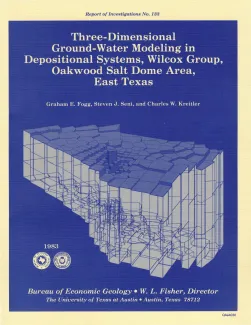
Publication Details
Geolocation:
Get the Publication
$11.50
Abstract/Description:
A three-dimensional model was constructed of ground-water flow in the Wilcox-Carrizo aquifer system near Oakwood salt dome to facilitate understanding the hydrogeology around salt domes of the Gulf interior region and ultimately to evaluate the hydrologic suitability of Oakwood Dome for storage of high-level nuclear waste. The data base includes not only measurements of hydraulic head and hydraulic conductivity but also lithofacies maps constructed in a previous study of Wilcox depositional systems. The Carrizo aquifer is a fairly homogeneous sand sheet overlying the much thicker Wilcox Group, a multiple-aquifer system composed primarily of fluvial channel-fill sand bodies distributed among lower permeability interchannel sands and muds. The interconnectedness of the channel-fill sands, which have predictable values of hydraulic conductivity, strongly influences the rate and direction of ground-water flow. Lateral interconnectedness may depend largely on frequency distributions of channel-fill sands (that is, sand percent). Vertical interconnectedness is apparently poor owing to the horizontal stratification of sand and mud. Simulating observed pressure-depth trends by manipulating values of equivalent vertical hydraulic conductivity (K,') demonstrates that the ratio of vertical to horizontal conductivity (K,'/Khr) is very low (approximately 10 -3 to 10-4). Locally high values of K,' could result in locally rapid vertical flow, which could in turn be detected using pressure-depth data. Ground-water velocities and travel times computed by the model indicate ground-water residence times of 103 to 104 years in channel-fill facies and 105 to 106 years in interchannel facies. Because Oakwood Dome is apparently surrounded by interchannel facies as a result of syndepositional dome growth, the dome may be essentially isolated from circulating Wilcox ground water. A possible exception is where channel-fill facies appear to touch or come close to the northeast flank, coinciding with a brackish-water plume that apparently results from dissolution of salt or cap rock. The northeast orientation of the plume appears to be caused by sand-body distribution and interconnection.